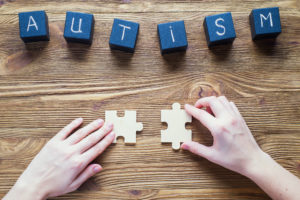An Autism Spectrum Disorder (ASD) (previously known also as Autism, Asperger’s Disorder and Pervasive Developmental Disorder) is characterised by persistent deficits in social communication and social interaction across a range of life contexts (eg. home, school, general community, occupational). Social communication and social interaction deficits are seen in three primary areas including:
- Social reciprocity (ie. the to and fro of interaction and conversation, sharing of interests and emotions, showing and bringing things to others)
- Non-verbal communicative behaviours used for social interaction (eg. eye contact, gestures, facial expressions and the pairing of these with verbal communication)
- Development, maintenance and understanding of relationships (ie. interest in others especially peers, appropriate social behaviour and adjusting behaviour to suit a social situation, sharing play and engaging in functional and imaginative play).
In addition to the above, an ASD requires the presence of restricted, repetitive patterns of behaviour, interests and activities. This can but does not exclusively include the following:
- Unusual or repetitive motor movements (eg. hand flapping, grimacing, rocking), speech (ie. echolalia, jargon and chunked or rote language) or use of objects/toys (eg. lining up, spinning).
- Excessive adherence to routines (eg. a need for specific routines or steps to be followed), ritualised patterns of verbal/non-verbal behaviour (eg. repetitive questioning or talking about a topic, rituals or compulsions), or excessive resistance to change (ie. difficulties with transitions, rigid thinking, having their own agenda or being ‘rule’ driven).
- Highly restricted and abnormally fixated interests (eg. unusual preoccupations such as with letters or numbers, obsessions, attachment to inanimate objects).
- Sensory sensitivities or interests (eg. distressed by certain sounds or textures, unusual sensory exploration of objects (sound/taste/smell), unusual visual inspection of things, under reaction or indifference to pain).
Previous names for ASD
Autistic Disorder, Autism (ie. ‘High or Low Functioning’ Autism), Asperger’s Disorder, Childhood Disintegrative Disorder, and Pervasive Developmental Disorder-Not Otherwise Specified (PDD-NOS) are all previous names for, or categories of an ASD. These individual labels are no longer used. In May 2013 the umbrella term of “Autism Spectrum Disorder” was introduced and each of these previous categories now fit under the one general term. The reason for this is that the individual diagnoses and symptoms of each are now better seen as falling upon a continuum. The general diagnostic term recognises the variety of presentations and individual differences in those who have an ASD.
Children, adolescents and adults who are diagnosed with an ASD may or may not present with developmental delays (eg. delays in fine or gross motor skills, self-care skills) as well as intellectual impairment or language delays/impairment. It is therefore often helpful to have children and adolescents assessed by a trained psychologist using developmental or cognitive tests.
Diagnoses of ASD can be made at any point in time across the lifespan. Symptoms and deficits are typically recognised in children from the age of 2 years, and these often become more evident between the ages of 3 and 5 years. Developmental regression (ie. a loss of developmental skills) at approximately 2 years of age can occur but is considered rare and not the norm. Diagnosing an ASD in adulthood is considered more challenging as adults have often learnt to compensate for social communication and social interaction difficulties.
Diagnosis and Assessment of ASD
The ‘gold-standard’ assessment of ASD frequently involves a multidisciplinary team approach. Liaison between psychologists, paediatricians or psychiatrists and/or speech pathologists is an important part of accurate assessment and diagnosis.
Comprehensive and accurate assessment of an ASD typically involves a thorough diagnostic and developmental interview with parents, liaison and consultation with other health/allied health or childcare/school professionals, a childcare or school observation in conjunction with an ASD-specific assessment (using the Autism Diagnostic Observation Schedule-Second Edition; ADOS 2). The ADOS 2 is a sensitive and specific social- and play-based tool which requires significant training and expertise to administer and interpret.
Some of the symptoms or criteria listed above do not solely occur in ASD and the consideration and assessment of context including developmental, family, behavioural and psychosocial contexts are very important. For example, some repetitive behaviours such as mouthing or sucking objects can be considered developmentally appropriate at certain ages. Similarly, rigid thinking and ‘own agenda’ ways of interacting can be seen in many children or can be better explained by behavioural diagnoses (eg. Oppositional defiance disorder). The context and persistence of symptoms as well as the overall combination of difficulties and behaviours are all very important when considering whether an ASD is an appropriate diagnosis for a child or adolescent.
Intervention for ASD
There are a range of interventions offered to assist children and adolescents who have been diagnosed with an ASD. It is important to consider what your child or adolescent’s particular strengths and weaknesses are and to engage in early intervention that is tailored to their needs. A number of programs exist that have been proposed as treatments for ASD but are not considered to be evidence-based. These include dietary restrictions, dietary supplement programs, and sensory interventions. It is important to consult a registered professional to discuss various treatments that are available and the research supporting their efficacy.
In general, there is evidence that children and adolescents with ASD can benefit from interventions that focus on the following:
- Speech and language development, appropriate verbal and non-verbal communication and functional, creative/imaginative and cooperative play (eg. turn-taking, following rules in games).
- Reciprocal social and conversational skills (eg. social problem-solving, friendship and relationship development, appropriately reading social cues and contexts, learning social rules and appropriate social behaviours as well as how to initiate and engage in conversations.
- Cooperation with adult-direction and coping with transitions and change.
- Developing more flexible thinking styles and ways of perceiving and interpreting situations.
- Attention and engagement in a range of developmental, academic and social activities.
- Fine motor and self-care skill development (eg. dressing, toileting).
- Reducing anxiety and the presence of anxious/repetitive behaviours.
- Reducing the interference of fixed interests, obsessions and preoccupations in daily life, learning and employment.
- Improving mood and general emotion coping.
- Building self-esteem and confidence.
Where to go from here?
If you would like to find out more about our assessment and treatment for Autism Spectrum Disorder, or to book an appointment, please make an enquiry or call the clinic on 02 9438 2511.

